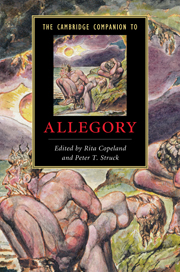Book contents
- Frontmatter
- Introduction
- Part I: Ancient foundations
- Part II: Philosophy, theology, and poetry 200 to 1200
- Part III: Literary allegory: philosophy and figuration
- Part IV: The fall and rise of allegory
- 15 Romanticism’s errant allegory
- 16 American allegory to 1900
- 17 Walter Benjamin’s concept of allegory
- 18 Hermeneutics, deconstruction, allegory
- 19 Allegory happens: allegory and the arts post-1960
- Further reading
- Index
18 - Hermeneutics, deconstruction, allegory
from Part IV: - The fall and rise of allegory
Published online by Cambridge University Press: 28 January 2011
- Frontmatter
- Introduction
- Part I: Ancient foundations
- Part II: Philosophy, theology, and poetry 200 to 1200
- Part III: Literary allegory: philosophy and figuration
- Part IV: The fall and rise of allegory
- 15 Romanticism’s errant allegory
- 16 American allegory to 1900
- 17 Walter Benjamin’s concept of allegory
- 18 Hermeneutics, deconstruction, allegory
- 19 Allegory happens: allegory and the arts post-1960
- Further reading
- Index
Summary
Allegory is narrative with a shadow story of corresponding characters, events, or ideas. Allegorical interpretation establishes the meaning of this figurative relation by tracing its correspondences of actions and concepts. Such working definitions will need revision as we consider the critical traditions of hermeneutics and deconstruction. In the second half of the twentieth century, these two ways of thinking offered unique perspectives on allegory as both a mode of writing and a strategy for reading. For the purposes of this essay, we can view hermeneutics generally as theories of interpretation, the establishment of textual meaning, especially those theories associated with the writings of Hans-Georg Gadamer and Paul Ricoeur. More provisionally, we can treat deconstruction as a radical form of poststructuralism and a certain way of interpreting against the grain of a text, developed within and against phenomenology and structuralism and often identified with the critical readings of Paul de Man and Jacques Derrida. Hermeneutics and deconstruction intersect and diverge on their shared topic of allegory in its relation to rhetoric, philosophy, and literature. We begin with two very different figures who set the rhetorical stage for later developments in hermeneutics and poststructuralism. Early in the century, Martin Heidegger's ontological rereadings of Western theology and philosophy included suggestive comments on allegory in his 1930-31 lecture course on “The Essence of Truth.”
- Type
- Chapter
- Information
- The Cambridge Companion to Allegory , pp. 254 - 265Publisher: Cambridge University PressPrint publication year: 2010



